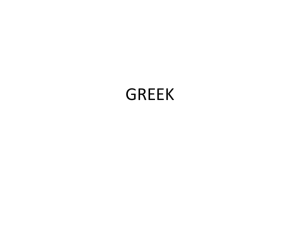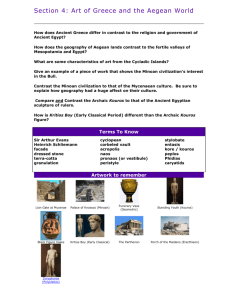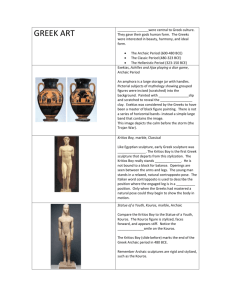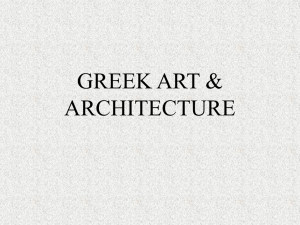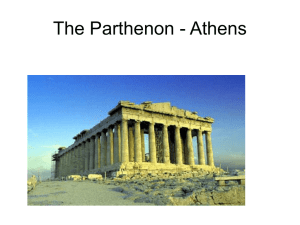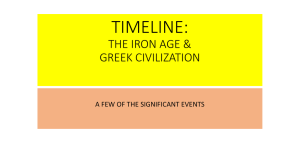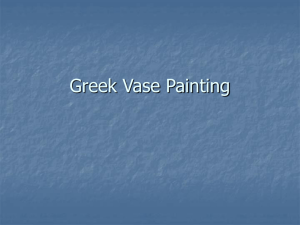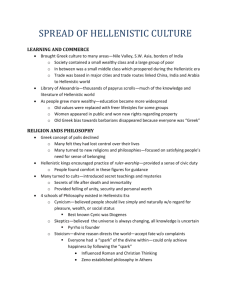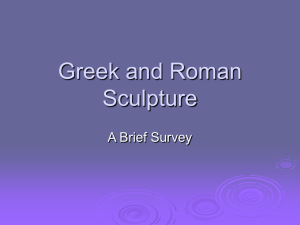Greek Sculpture - OCPS TeacherPress
advertisement
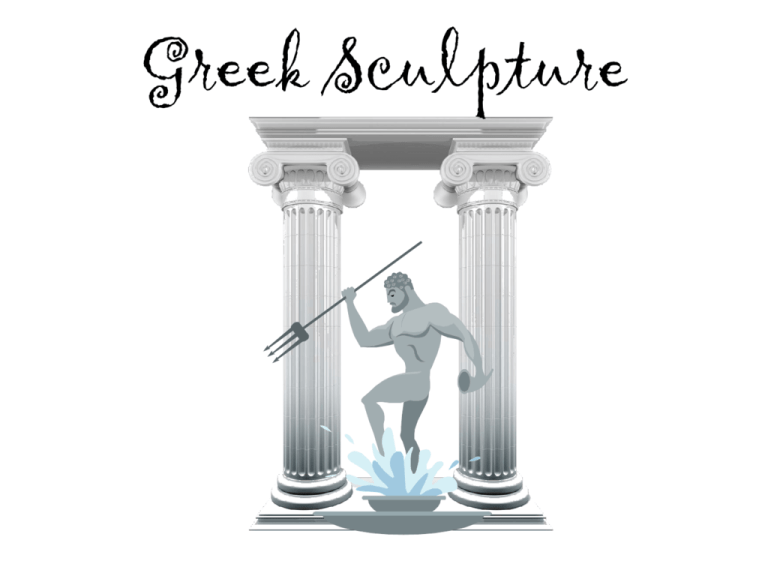
Greek Sculpture Archaic • • • • • • • • • • • Kore 660 BC to 590 BC Archaic Period All female youth sculptures were called Kore. Made of marble Would have been painted with bright colors and decorated. Archaic smile-corners of her mouth slightly lifted. Hair is carved down the back showing Egyptian influence. Would have been found in and around temples holding an offering in her outstretched hand. The Kore were always clothed. Not meant to house the soul or KA at death but may have been used as graver markers. Represented the ideal female youth. Flesh would have been painted lighter than the male kouros. Kouros 660 BC to 590 BC • 1st appearance coincides with trade with Egypt. • Usually a votive statue (representing a hero or athlete) or a grave marker. • Represented the god Apollo. • All male statues were called kouros and were nude. • Represented the ideal male youth. • Flesh would have been painted brown or red. classical The Discus Thrower by Myron • 480-440 BC • Roman copy of a Greek sculpture. • Shows an athlete in motion performing the Olympic event discus throwing. • Athletes performed nude • Romans copied all the Greek sculptures. • • • • • • • • • • • • Venus de Milo 150 BC Classical Period Sculpted by Alexandros of Antioch Statue of Aphrodite (Venus) Located at the Louvre museum in Paris Found on the island of Milos in 1820 Milos means “apple” in Greek Would have been painted and adorned with jewelry Made of marble 6’8 feet tall The arms were lost in transport. Her face is neutral and drapery is realistic Known for perfect graceful proportions Doryphorus (the spear bearer) 450 BC-415 BC • Polykleitos of Argos • Bronze • Known for his sculptures of young athletes • Known only through Roman copies • Perfect proportions • Idealized • Classical period • Contrapposto stance Hellenistic The Seated Boxer 225 BC • Votive statuecommemorated a known boxer. • More realistic • Hellenistic Period • Shows emotion • bronze Laocoon Group 200 BC-70 A.D. • Laocoon was a seer and a priest for Apollo • He offended Apollo by bringing his wife into the temple and by warning the Trojans about the Horse. • As he and his sons were about to sacrifice a bull he sent sea serpents to crush and kill them. • Figures are life-size • Found in 1506 AD (during the Italian Renaissance) • Michelangelo helped excavate it. • Influenced the Renaissance artists. They Dying Gaul 230-220 BC • • • • Hellenistic Bronze Roman copy A Celt warrior (considered barbarians) • Serves as a reminder of civilization over barbarians • Celts fought naked • Represents a warrior in the final stage before death from a wound in his chest. Nike of Samothrace 295 BC-289 BC • Represents the goddess of victory. • Located in the Louvre • In was originally the bow of a war ship. • 8 ft tall • Made of marble • Hellenistic • The NIKE logo is based off of the curve of her wing. Comparing Sculptures The Archaic Period How are Mentuemhet and the Kouros different? Mentuemhet, Egypt, Dynasty XXVI, 650 BC Kouros Greece ca. 600 BC The Archaic Period Differences between Egyptian and Greek statuary The Greek statues are liberated from the original stone block, where the Egyptian statues were not. This demonstrates the Greek idea of including motion rather than stability. The kouroi are nude and absent of any attributes The proportions of the body are slightly less idealized than those from Egypt. Mentuemhet, Egypt, Dynasty XXVI, 650 BC Kouros Greece ca. 600 BC Compare and contrast: Kroisos vs. Kritios Boy Pose: Rigid→ relaxed but balanced Weight shift: both legs → on the left leg Facial expression: smiling → solemn, contemplative (P.112 Figure 5.8) (P.113 Figure 5.9) Spear-Bearer V.S. Apollo Belvedere Pose: contropposto→ showing action Weight shift: weight on right leg, contrapposto → leg stepping back in action Facial expression: neutral, calm→solemn, contemplative . Hellenistic Classical Carving Techniques • Contrast of light and dark • Semi-transparent robes • Vigorous movement • Deeply cut drapery
